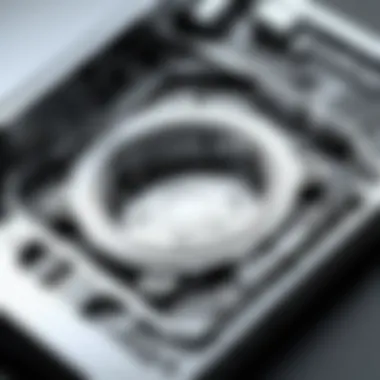The Impact of CAD CAM Designers on Modern Industry


Intro
In today’s rapidly evolving industrial landscape, the role of CAD CAM designers becomes increasingly significant. These professionals are at the forefront of technological innovation, bridging the gap between design and manufacturing. Their expertise is essential for optimizing production processes and enhancing product quality across various sectors.
The intersection of computer-aided design (CAD) and computer-aided manufacturing (CAM) empowers designers to visualize intricate details and precisely control manufacturing methods. This article delves into the various facets of CAD CAM design and its pivotal impact on modern industry.
Software Overview
Purpose and function of the software
CAD CAM software serves a dual purpose: it facilitates the design of products and manages the manufacturing processes that follow. Designers use CAD tools to create detailed three-dimensional models, which can include everything from mechanical components to architectural structures. Once designs are finalized, CAM software takes over to translate these models into instructions that guide automated machinery during production.
Key features and benefits
- Precision: CAD CAM software allows for highly accurate designs, minimizing errors during the manufacturing phase.
- Efficiency: Automating the design and manufacturing processes reduces production times significantly.
- Versatility: These tools can cater to various industries such as aerospace, automotive, and architecture, enhancing their wide applicability.
- Integration: Many CAD CAM systems can integrate with other enterprise software, improving the overall workflow.
The incorporation of features like parametric design helps designers make quick adjustments, ensuring adaptability to client feedback and market changes.
Installation and Setup
System requirements
Before installing CAD CAM software, ensure that the system meets specific requirements. These often include:
- Processor: A multi-core processor for efficient performance.
- Memory: A minimum of 8 GB RAM, although 16 GB is preferred for more complex operations.
- Graphics Card: A dedicated graphics card capable of handling 3D rendering tasks.
- Storage: Sufficient disk space, often recommended at least 1 TB, especially for large design files.
Installation process
To install CAD CAM software, follow these simple steps:
- Download the software from the official site or a reliable source.
- Run the installer, following the on-screen instructions.
- Enter any necessary license information during setup.
- Configure settings as required, such as file destination and user preferences.
- Finish the installation and restart the computer if prompted.
By understanding these vital aspects of CAD CAM design, both establishing professionals and aspiring students can navigate the complex landscape of modern industrial practices. The implementation of CAD CAM tools undoubtedly raises the standards of design quality and production efficiency.
Prologue to CAD CAM Design
The field of CAD CAM design plays a pivotal role in modern industry, serving as the bridge between creative concepts and tangible products. The integration of computer-aided design (CAD) and computer-aided manufacturing (CAM) has revolutionized how designers and engineers approach the development process. This section will outline the essential aspects of CAD CAM, highlighting its broader significance in everyday industrial operations.
Definition of CAD CAM
Computer-Aided Design (CAD) refers to the use of digital tools to create, modify, analyze, or optimize designs. CAD software enables designers to illustrate products in a virtual environment before actual production begins. This technology encompasses various disciplines including mechanical, architectural, and electrical design. On the other hand, Computer-Aided Manufacturing (CAM) involves using software and computer-controlled machinery to automate the manufacturing process. In essence, CAD focuses on design, while CAM emphasizes the production aspect of that design.
Importance of CAD CAM Designers
CAD CAM designers are crucial in ensuring that the transition from concept to manufacturing is seamless. Their skills and expertise enable them to effectively utilize software to create precise models and optimize production processes. The significance of these designers includes the following points:
- Efficiency: CAD CAM designers streamline workflows, reducing lead times and enhancing productivity.
- Accuracy: The use of CAD tools ensures high levels of precision in design, which translates to fewer errors in manufacturing.
- Innovation: Designers who specialize in CAD CAM are at the forefront of technological advancements, contributing to product innovation.
- Collaboration: CAD CAM facilitates easier sharing and collaboration among team members, allowing for faster iterations and feedback.
"The blend of CAD and CAM technologies marks a significant milestone in the evolution of design and manufacturing processes, setting new standards for productivity and product quality."
Ultimately, the role of CAD CAM designers extends beyond simple design tasks. They serve as pivotal operators in a highly technical environment, combining creativity with engineering principles to transform ideas into functional products.
Historical Development of CAD CAM Technology
The history of CAD CAM technology is crucial to understanding the significant advancements in design and manufacturing processes. As industries shifted towards automation and digitalization, the role of CAD CAM designers became increasingly important. This section will explore how the journey of computer-aided design and manufacturing has shaped modern industry, emphasizing key milestones, innovations, and the transformative impact on various sectors.


Early Computer-Aided Design
The inception of computer-aided design began in the 1960s. Before this period, design processes were manual, relying heavily on physical drawings and models. The introduction of systems like Ivan Sutherland’s Sketchpad marked a pivotal moment. This software allowed designers to interact with graphics on a screen for the first time. It enabled functionalities such as object manipulation, which significantly reduced the time needed to produce design iterations. The potential for error was also minimized, as designs could be modified quickly without starting from scratch.
As subsequent decades progressed, CAD tools evolved further, integrating capabilities for 3D modeling and visualization. Companies like Autodesk launched AutoCAD in 1982, revolutionizing how designers approached their work. The intuitive graphical interface made CAD accessible, allowing designers to create complex geometries with ease. This shift introduced efficiency in industrial practices that was previously unattainable. CAD designers became integral to industries ranging from automotive to aerospace, as their abilities to produce accurate models resulted in faster production timelines.
The Emergence of CAM Systems
Computer-Aided Manufacturing systems emerged in tandem with CAD. The late 1970s and early 1980s witnessed the realization of integrating CAD with CAM. This combination allowed for direct communication between design and manufacturing processes, further enhancing operational efficiency. Notably, companies could now transfer designs directly from CAD software to CNC (Computer Numerical Control) machines for precise manufacturing.
This synergy fostered a more streamlined process, reducing the risk of errors during production. The advantages of CAM systems became evident as manufacturers adopted technologies like laser cutting and milling, which relied on CAD-generated instructions. As a result, the production became not only faster but also more versatile, able to accommodate complex designs without necessitating significant manual intervention.
The integration also paved the way for innovations like Rapid Prototyping and 3D printing, which heavily depend on the flawless collaboration between CAD and CAM. Both fields have continued to evolve, pushing boundaries and setting new standards in product design and manufacturing.
In summary, the historical development of CAD CAM technology provides context for its current applications and significance in modern industries. It highlights a trajectory of innovation, demonstrating how the evolution of these systems is rooted in the need for efficiency, accuracy, and adaptability in an increasingly competitive market. Advanced CAD CAM designers today stand on the shoulders of these early developments, utilizing sophisticated tools to meet the demands of their industries.
Core Skills of a CAD CAM Designer
The field of CAD CAM design is intensely competitive and constantly evolving. The core skills of a CAD CAM designer are not just beneficial; they are essential for success in modern industries. Mastery of these skills ensures that designers can navigate challenges effectively while delivering high-quality designs. Understanding these competencies can provide insights into how CAD CAM designers contribute to productivity within their respective sectors.
Technical Proficiency in Software
Proficiency in software tools is fundamental for any CAD CAM designer. This ability goes beyond mere familiarity. It requires deep knowledge of specific software packages like AutoCAD, SolidWorks, and CATIA. Each of these tools has unique features that enhance design capabilities. Almost every project demands a different approach, so being versatile is crucial. Designers must stay updated with latest software updates and industry trends, as software capabilities evolve quickly. This expertise boosts accuracy in designs, minimizes errors, and accelerates the entire design process.
Understanding of Engineering Principles
A strong grasp of engineering principles is vital for CAD CAM designers. They must understand mechanical functions, materials properties, and production methods. This knowledge allows them to create designs that are not only innovative but also feasible in real-world applications. Understanding concepts such as load distribution and material strength directly impacts product performance and durability. Thus, competency in these areas can enhance the overall quality of a design.
Attention to Detail
Attention to detail is a critical skill that CAD CAM designers must possess. Small errors in designs can lead to significant problems during manufacturing. This could cause delays and increase costs. Designers need to scrutinize every aspect of their work, from dimensions to tolerances. This meticulous approach can lead to better outcomes and improve the reliability of products. Therefore, developing this skill is essential to ensuring that designs meet project requirements and industry standards.
Problem-Solving Abilities
Problem-solving skills are essential in the CAD CAM design process. Designers often face unexpected challenges. These can include design flaws, production limitations, or material shortages. The ability to think critically allows designers to assess situations quickly and implement effective solutions. They must analyze the problem, weigh options, and make decisions under tight deadlines. Mastering this skill enhances their effectiveness and adaptability in various environments.
Key Software Tools for CAD CAM Design
The significance of software tools in CAD CAM design cannot be overstated. These tools serve as the backbone for designers, enabling them to effectively create, manipulate, and communicate their ideas. By understanding and leveraging the appropriate software, CAD CAM designers can enhance their productivity and precision. This section outlines the landscape of essential software tools used in CAD and CAM processes, highlighting their roles, functionalities, and benefits.
Overview of Popular CAD Software
CAD software is designed to facilitate the creation of detailed drawings and models. The market presents a variety of options, each catering to distinct needs and preferences. Popular CAD software includes AutoCAD, SolidWorks, and Autodesk Inventor.
- AutoCAD: Widely recognized for its versatility, AutoCAD is used across various industries. Its ability to create both 2D and 3D designs makes it a staple for designers.
- SolidWorks: This software is known for its simulation capabilities, allowing users to analyze how designs perform under real-world conditions. Its intuitive interface enhances user experience, making it a favorite among engineers.
- Autodesk Inventor: Inventor focuses on product design and provides tools for 3D mechanical design. This software is useful for designing complex assemblies.
Each of these programs offers unique features that can streamline workflows and improve the accuracy of designs.
Leading CAM Solutions
CAM solutions translate CAD models into instructions that machines use for manufacturing. Effective CAM software is crucial for ensuring that designs are accurately realized on the production floor. Leading CAM solutions include Mastercam, Fusion 360, and Siemens NX.
- Mastercam: A robust program, Mastercam is favored for its user-friendly interface and extensive machining capabilities. It supports various types of machining processes, ensuring compatibility with different equipment.
- Fusion 360: Offering a cloud-based platform, Fusion 360 integrates CAD and CAM into one application. This allows for seamless collaboration and offers features like generative design and simulation.
- Siemens NX: This high-end solution integrates advanced simulation, design, and manufacturing tools. Its ability to handle complex assemblies sets it apart.
The choice of CAM software can profoundly affect production efficiency, making it essential for designers to select tools that align with their specific operational needs.


Integrating CAD and CAM Systems
The integration of CAD and CAM systems is an evolving trend in the industry. Effective integration allows for a more streamlined workflow and reduces the chances of errors during the transition from design to manufacturing. To achieve integration, tools such as PLM (Product Lifecycle Management) systems are often employed.
Benefits of integrating CAD and CAM systems include:
- Increased Efficiency: Designers spend less time transferring data manually.
- Reduced Errors: Automatic data transfer minimizes the risk of human error, leading to higher-quality products.
- Enhanced Collaboration: Teams can collaborate in real time, facilitating a more unified approach to design and manufacturing.
The Impact of CAD CAM Designers on Industries
The role of CAD CAM designers is critical across various industrial sectors. They contribute significantly to the enhancement of productivity and efficiency in design and manufacturing. By optimizing processes and facilitating innovation, CAD CAM designers help industries adapt to rapidly changing market demands.
Manufacturing Sector Innovations
CAD CAM designers have transformed the manufacturing sector with their unique approach. This change can be seen in the integration of design and production processes. CAD software allows designers to create precise models, while CAM systems facilitate the automated production of these designs.
- Improved accuracy: CAD CAM systems ability to create detailed designs leads to higher accuracy in manufacturing processes which reduces waste and errors.
- Increased efficiency: By combining the CAD and CAM processes, manufacturers achieve faster turnaround times. Automation reduces the amount of manual labor required, optimizing resources.
- Customization: Designers can easily modify designs based on client needs, allowing for greater product variety without compromising production speed.
These innovations drive competitiveness in manufacturing, enabling industries to respond more swiftly to changes in consumer preferences.
Architecture and Construction Enhancements
In the fields of architecture and construction, CAD CAM designers play a vital role. They influence how structures are conceptualized and built.
- Visual representation: Using CAD tools, architects can create 3D models, helping clients visualize projects before construction. This reduces misunderstandings and improves client satisfaction.
- Streamlined workflows: The integration of CAD and CAM supports seamless collaboration among architects, engineers, and contractors. This joint effort ensures that projects stay on schedule and within budget.
- Material-efficient designs: Advanced modeling techniques enable designers to optimize the use of materials, which is crucial in reducing costs and environmental impact.
The synergy between design and construction creates spaces that are not just functional but also innovative and enduring.
Medical Device Design Advances
The medical industry benefits significantly from the expertise of CAD CAM designers. The accuracy and precision required in this realm are critical for developing advanced medical devices.
- Robotic surgical instruments: Designers use CAD CAM software to create intricate devices that enable surgeons to perform complex procedures with improved precision.
- Custom implants: CAD technology allows for the creation of tailored implants that match the unique anatomy of patients. This customization can lead to better surgical outcomes and faster recovery.
- Rapid prototyping: CAM technologies facilitate the rapid prototyping of new devices, allowing for quicker testing and iteration. This speeds up the time from concept to market.
Overall, CAD CAM designers play an integral role in shaping the future of medical innovations, ensuring that devices are safer, more effective, and tailored to individual needs.
CAD CAM designers are at the forefront of revolutionizing several industries. Their work leads to enhancements that not only improve efficiency but also foster innovation and sustainability.
Challenges Faced by CAD CAM Designers
In the rapidly evolving landscape of design and manufacturing, CAD CAM designers encounter various challenges that impact their work and overall effectiveness. Understanding these challenges is essential to grasp the complexities of the profession.
Keeping Up with Technological Advancements
The pace of technological growth in CAD CAM is relentless. Designers must continuously adapt to new software updates and tools. Regular training is necessary to understand the latest features and functionalities of programs such as AutoCAD and SolidWorks. This demands time and resources that many designers may struggle to allocate.
Staying current means grasping innovations like generative design and predictive analysis. As technology advances, so do the tools available for designers. Failing to keep pace can result in outdated techniques that could hinder a designer's ability to compete effectively in the market.
Collaborative Project Difficulties
Collaboration is crucial in any design project. However, CAD CAM designers often face challenges when working with multidisciplinary teams. Diverse skillsets, backgrounds, and perspectives can lead to misunderstandings. Designers need to coordinate with engineers, clients, and other stakeholders effectively. Miscommunication can result in delays and potential errors in the design process.
Different teams use various software, which complicates seamless integration. Designers must find ways to work around compatibility issues. Employing effective project management software can assist, yet, it still requires effort from all parties involved. The adoption of standards and protocols within teams can help alleviate some friction.
Managing Client Expectations


Balancing client expectations with project realities is another significant challenge. Clients often have high demands. They want designs to be completed quickly while also meeting specific quality standards and budget constraints. This can put immense pressure on CAD CAM designers to deliver results with limited resources.
Effective communication is vital. Designers should set clear timelines and transparent pricing structures when discussing project scopes with clients. Engaging clients in the design process can also lead to better outcomes. When clients are informed and involved, they understand the challenges and limitations. This leads to more realistic expectations that align with project realities.
"Communication and clear expectations are essential in managing the client relationships for successful project outcomes."
Using project management tools can assist in updating clients on progress. Simple updates can go a long way in building trust and ensuring that client requirements are being met. Ultimately, this benefits both the designers and the clients involved.
The challenges faced by CAD CAM designers are multifaceted. Navigating the demand for technological expertise, effective collaboration, and client satisfaction require considerable skill and effort. Addressing these challenges thoughtfully can improve productivity and lead to innovative design solutions.
Future Trends in CAD CAM Design
The rapid evolution of technology makes exploring future trends in CAD CAM design essential for staying relevant in the industry. These developments impact not only design methodologies but also manufacturing processes and end-product quality. Understanding these trends enables CAD CAM designers to lead innovation, thus ensuring competitive advantages for their organizations.
The Role of Artificial Intelligence
Artificial intelligence (AI) is becoming a significant force in CAD CAM design. AI enhances productivity by automating repetitive tasks and providing insights that inform better decisions. For instance, AI algorithms analyze design patterns and suggest optimal modifications, enabling quicker iterations. Moreover, AI can predict potential manufacturability issues based on historical data, minimizing costly alterations during production. This integration of AI requires designers to adapt and learn how to utilize these tools effectively, which could shift traditional design roles towards more analytical responsibilities.
3D Printing Integration
The integration of 3D printing into CAD CAM processes marks a substantial shift in manufacturing capabilities. This technology allows for rapid prototyping and the production of complex geometries that were previously difficult or impossible to achieve. As designers become more skilled in 3D printing technology, they can explore innovative applications across various industries, such as aerospace and healthcare. The ability to create fully customized parts on demand improves efficiency and reduces waste in material usage. In this context, designers must collaborate closely with engineers to ensure designs are optimized for both functionality and manufacturability.
Sustainable Design Practices
Sustainability is increasingly becoming a pivotal concern in CAD CAM design. Designers are now tasked with incorporating eco-friendly materials and processes into their workflows. This shift toward sustainable design practices can lead to a reduction in the carbon footprint of manufactured products. CAD CAM designers must consider life cycle assessments during the design phase, determining how materials and processes impact the environment from production through disposal. Furthermore, embracing sustainable practices offers business advantages, as consumers increasingly favor environmentally responsible brands.
The Education Path for CAD CAM Designers
The education path for CAD CAM designers is pivotal in shaping proficient professionals who can thrive in an evolving industry. In this era of rapid technological advancement, the need for knowledgeable individuals in the field is paramount. Various educational programs provide foundational skills, advanced knowledge, and specialized training that empower designers to excel in their roles.
Relevant Degrees and Certifications
Pursuing a relevant degree is often the first step for aspiring CAD CAM designers. Common choices include:
- Bachelor's Degree in Engineering: This degree provides a strong base in engineering principles, crucial for effective design work.
- Bachelor's Degree in Industrial Design: These programs focus on design thinking and user-centered practices, which can enhance a designer's ability to meet client needs.
- Associate Degree in Computer-Aided Design: A more focused option, this degree typically covers essential CAD software skills and design fundamentals in a shorter time frame.
Certifications also play an important role. They demonstrate a designer's commitment to continual learning and proficiency with specific tools, such as:
- AutoCAD Certification
- SolidWorks Certification
- Mastercam Certification
These certifications validate technical abilities and often increase employability, giving candidates an advantage in a competitive job market.
Continuing Education Importance
Continuing education is indispensable in the CAD CAM landscape. As technologies and methods continue to evolve, it is essential for designers to stay updated. Participating in workshops, webinars, and courses helps in the following aspects:
- Skill Enhancement: This enables designers to learn about new tools and technologies, such as innovations in 3D printing or advanced software features.
- Networking Opportunities: Engaging in continuous education facilitates connections with industry peers, opening doors for collaboration and knowledge exchange.
- Career Advancement: Professionals who invest in their education often position themselves as leaders and experts in their fields. This enhances their chances for promotions and raises.
Investing time in both foundational education and ongoing professional development is essential for CAD CAM designers. This commitment leads to greater adaptability, broader skills, and higher quality work design.
"Continuous learning is the minimum requirement for success in any field." - Brian Tracy
Over time, the education path for CAD CAM designers contributes significantly to their career trajectory and the overall progress of the industry.
Epilogue
The conclusion of this article emphasizes the pivotal role that CAD CAM designers play in shaping modern industry. These professionals are not just technically proficient; they are indispensable in enhancing productivity and innovation. They bring a unique blend of skills that includes technical expertise, problem-solving abilities, and an understanding of complex engineering principles. This combination allows them to navigate challenges and deliver effective design solutions.
The Ever-Evolving Nature of CAD CAM
The field of CAD CAM design is constantly adapting. With the rapid advancements in technology, CAD CAM designers must embrace change and innovation. New tools and software emerge frequently, requiring designers to stay updated with the latest industry standards. For example, artificial intelligence is starting to play a significant role in design processes, optimizing workflows and reducing turnaround times. As a result, designers must integrate AI into their work to remain competitive. Furthermore, integrating techniques like 3D printing presents a fresh frontier, changing the way products are designed and manufactured.



